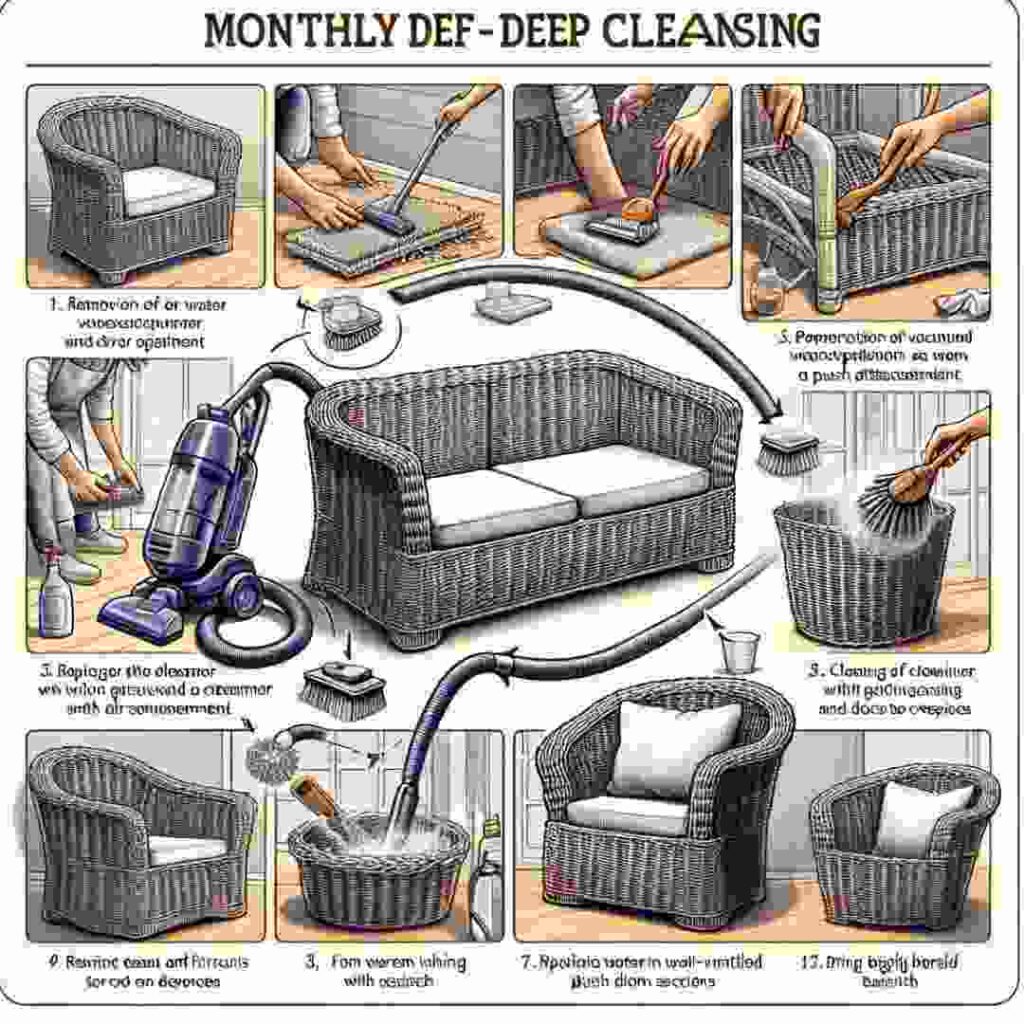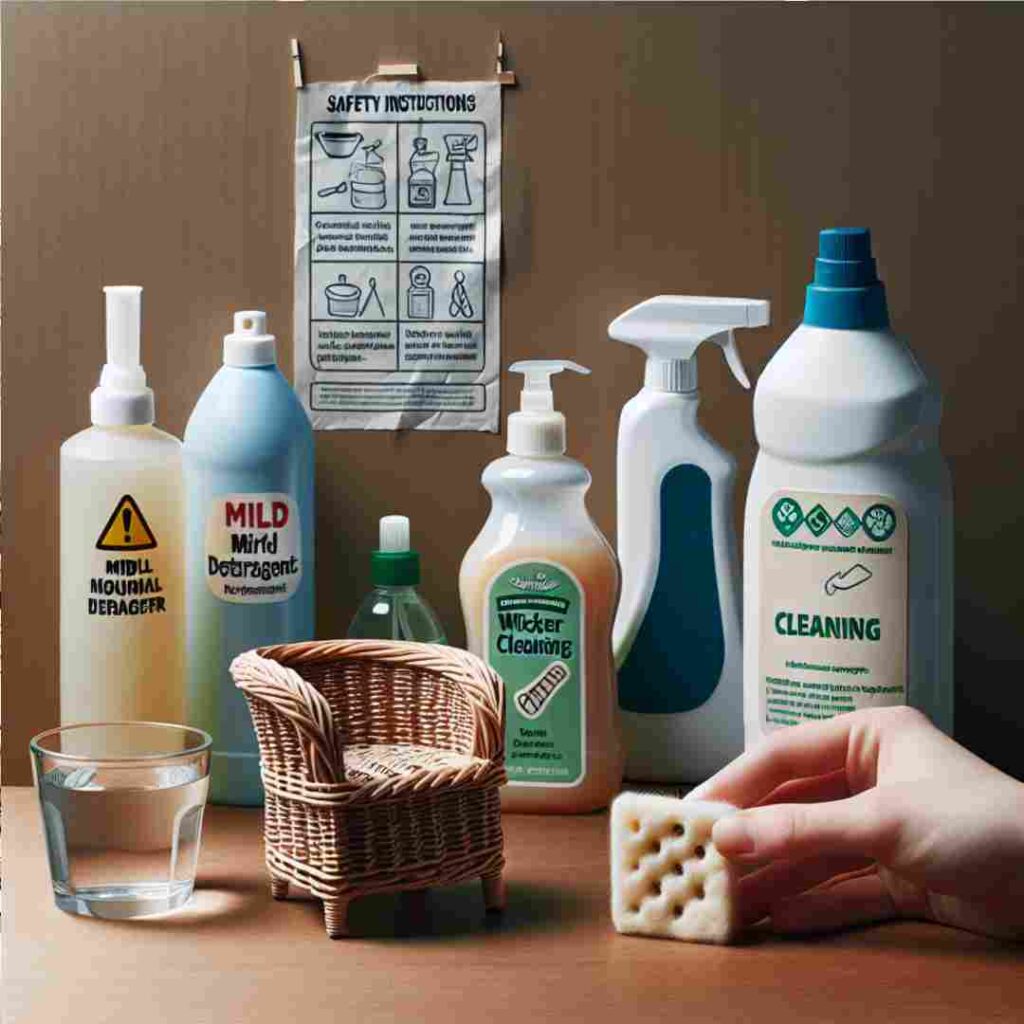Wicker furniture adds a touch of elegance and rustic charm to any home, patio, or garden. Its intricate designs and natural appeal make it a favorite among homeowners, DIY enthusiasts, and interior designers. However, maintaining that beauty requires some special care. In this blog post, you’ll discover the art and science of cleaning wicker furniture, ensuring it remains a centerpiece in your space for years. From everyday maintenance to deep cleaning techniques, we’ve got you covered.
Understanding Wicker Furniture
Wicker isn’t a material; it’s a weaving process primarily using natural fibers like rattan, bamboo, or willow. Some modern wicker furniture is made from synthetic materials like resin. Knowing your wicker type is crucial in determining the best cleaning method. Natural wicker is delicate and can be damaged by excessive moisture, while synthetic wicker is generally more durable and weather-resistant.
Natural wicker requires a gentle touch—it avoids harsh chemicals and excessive water, which can weaken the fibers. Synthetic wicker is more forgiving, making it a popular choice for outdoor use. Understanding this distinction will guide your cleaning approach and help maintain the integrity of your furniture.
Finally, consider how often your wicker furniture is used and exposed to the elements. Regular use and outdoor placement may require more frequent cleaning. Understanding these aspects allows you to tailor your cleaning routine to suit your furniture’s needs.
Daily Care for Wicker Furniture

Daily maintenance is vital to preserving the look and longevity of your wicker furniture. A simple dusting routine can go a long way in preventing dirt buildup and keeping your pieces looking fresh. Use a soft-bristled brush or a microfiber cloth to remove dust and debris from the surface and crevices gently.
For deeper cleaning, a vacuum with a brush attachment can reach those hard-to-clean nooks. This helps remove dirt and crumbs that may have settled between the weaves. Regular vacuuming cleans the furniture and prevents dust from becoming ingrained in the fibers.
Lastly, consider the placement of your wicker furniture. Keeping it away from direct sunlight and moisture will help prevent fading and deterioration. If your furniture is outdoors, use protective covers when not in use to shield it from the elements. These simple daily care tips will prolong the life of your wicker pieces.
Weekly Cleaning Routine
A weekly cleaning routine is essential for maintaining the appearance of wicker furniture. Start with a thorough dusting to remove surface dirt. Use a slightly damp cloth for natural wicker and a mild detergent solution for synthetic wicker to wipe down the surface. Be sure to wring out the cloth well to avoid soaking the wicker.
Next, address any spills or stains immediately. Blot with a clean, dry cloth to absorb as much liquid as possible. For stubborn stains, a mixture of water and mild dish soap can be applied with a soft cloth. Gently rub the area until the stain lifts, then wipe with a damp cloth to remove any soap residue.
Remember to inspect your furniture for any signs of wear or damage during your weekly cleaning. Tighten loose screws and repair any broken weaves promptly. This regular maintenance will prevent minor issues from turning into major repairs.
Monthly Deep Clean

A monthly deep clean is necessary to keep wicker furniture in pristine condition. Begin by removing cushions and any removable parts. Dust the entire piece using a vacuum cleaner with a brush attachment, paying attention to crevices where dust accumulates.
Prepare a cleaning solution using warm water and a few drops of mild detergent. Use a soft-bristled brush to clean the wicker, working in small sections. Rinse the brush frequently to prevent spreading dirt. Avoid soaking the wicker, as excess moisture can weaken natural fibers.
After cleaning, allow your furniture to dry completely in a well-ventilated area. For natural wicker, it’s best to dry indoors to prevent exposure to direct sunlight. Once dry, replace cushions and parts, and enjoy your refreshed and revitalized furniture.
Handling Mold and Mildew
Mold and mildew can be expected for wicker furniture, especially in humid climates. Early detection and treatment are crucial to preventing lasting damage. To avoid spreading spores indoors, begin by taking the furniture outdoors.
Mix equal parts water and white vinegar in a spray bottle. Lightly mist the affected areas and allow the solution to sit for 15 minutes. Use a soft cloth or brush to scrub the mold or mildew mildew gently. Rinse with a damp cloth and let the furniture dry completely in the sun.
To prevent mold and mildew from returning, ensure your furniture is dry before covering or storing it. Consider using a dehumidifier in indoor spaces where humidity is a concern. Regular inspections and prompt action will keep your wicker mold-free.
Repairing Wicker Furniture

Even with the best care, wicker furniture can suffer wear and tear over time. Broken strands or loose weaves are common issues that can often be repaired at home. For minor repairs, use a clear-drying glue to secure loose strands. Apply a small amount and hold the strand until the glue sets.
For more extensive repairs, such as replacing broken weaves, you may need to purchase a replacement wicker or call a professional. If you prefer DIY repairs, look for online tutorials or guides for your wicker type.
Regularly inspecting your furniture and addressing repairs promptly will extend its life and maintain its aesthetic appeal. With a little effort, your wicker pieces can remain beautiful and functional for years.
Seasonal Maintenance Tips
Seasonal changes can impact the condition of wicker furniture, especially outdoors. Clean your furniture thoroughly in the spring to remove any dirt or debris accumulated during winter. Check for damage and repair as needed.
During summer, protect your furniture from UV rays by using outdoor covers or moving pieces to shaded areas. Consider applying a protective sealant designed explicitly for wicker to provide an additional defense against the elements.
In the fall, prepare your furniture for winter storage. Clean each piece thoroughly, then store it in a dry, cool place. If indoor storage isn’t an option, use high-quality covers to protect your furniture from harsh winter conditions.
Choosing the Right Cleaning Products

Selecting the right cleaning products is crucial to maintaining the integrity of your wicker furniture. Avoid harsh chemicals and abrasive cleaners, which can damage the fibers. Opt for mild detergents or specially formulated products designed for wicker cleaning.
When using a new product, always test it on a small, inconspicuous area first. This will help you ensure it won’t cause discoloration or damage. Natural solutions, like vinegar and baking soda, can be effective for cleaning and deodorizing without the risk of harm.
Commercial cleaning products are generally safe for synthetic wicker but always follow the manufacturer’s instructions. By choosing the right products, you’ll preserve the beauty and durability of your wicker furniture for years to come.
Protecting Wicker from the Elements
Protection from the elements is critical to extending the life of wicker furniture, mainly when used outdoors. Rain, sun, and wind can all damage wicker over time. Using furniture covers when pieces are not in use is an effective way to shield them from weather-related damage.
For natural wicker, consider applying a protective varnish or sealant to create a barrier against moisture. This can help prevent the fibers from weakening and extend the longevity of the furniture. While more resilient, synthetic wicker can still benefit from occasional protective treatments to avoid fading and wear.
Positioning your furniture in sheltered areas, such as under a patio cover or awning, can also reduce exposure to harsh conditions. These preventative measures will help maintain the appearance and functionality of your wicker pieces.
Revitalizing Old Wicker Furniture

Revitalizing old wicker furniture can breathe new life into tired pieces and transform them into stylish additions to your home. Start by cleaning the furniture thoroughly, following the steps outlined in this guide. Address any repairs and tighten loose weaves to restore structural integrity.
Consider refreshing the look of your furniture with a new coat of paint or stain. Choose colors that complement your existing decor and use spray paint specifically designed for wicker to ensure even coverage. A fresh finish can update your furniture and protect it from future wear.
Updating accessories, such as cushions and throws, can also enhance the appearance of your revitalized wicker furniture. By investing a little time and creativity, you can revive old pieces and enjoy them for many more years.
Frequently Asked Questions
How do I prevent my wicker furniture from getting brittle?
To prevent brittleness, regularly clean and moisturize your wicker furniture. Use a damp cloth for cleaning and apply a light coat of furniture oil or wax to keep the fibers supple. Avoid excessive exposure to direct sunlight, which can cause drying and cracking.
Can I leave my wicker furniture outside all year round?
While synthetic wicker is designed to withstand outdoor conditions better than natural wicker, it’s still advisable to use protective covers and store furniture in a sheltered area during extreme weather. This will help prolong its life and maintain its appearance.
What should I do if my wicker furniture gets wet?
If your wicker furniture gets wet, wipe it down with a dry cloth and let it air dry thoroughly in a well-ventilated area. Avoid placing it in direct sunlight or using heat sources to speed up drying, which can lead to warping or damage.
Is it safe to use bleach on wicker furniture?
Using bleach on wicker furniture is not recommended as it can weaken the fibers and cause discoloration. Stick to mild cleaning solutions like water and vinegar, rinse thoroughly to prevent buildup.
How often should I inspect my wicker furniture for damage?
Regular inspections should be conducted at least once every season. Check for any signs of wear, such as loose weaves or broken strands, and address these issues promptly to prevent further damage. Regular maintenance will help keep your furniture in good condition.
Conclusion
Wicker furniture is a beautiful and versatile addition to any home, but it requires a bit of TLC to keep it looking its best. By understanding the unique needs of wicker, establishing a regular cleaning routine, and taking preventative measures, you can ensure your furniture remains stunning and durable. Whether you’re a homeowner, a DIY enthusiast, or an interior designer, these tips and tricks will help you maintain the charm and elegance of your wicker pieces for years to come. If you’re ready to take your wicker care skills to the next level, explore our additional resources or contact a professional for personalized advice.











